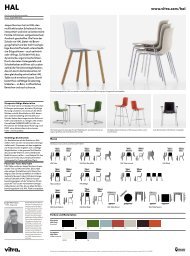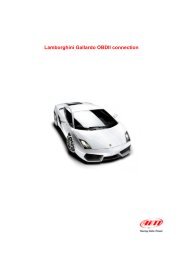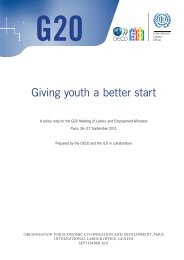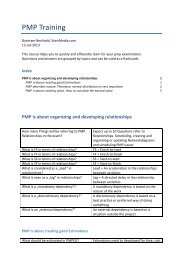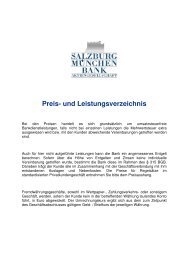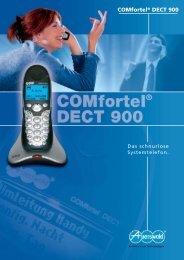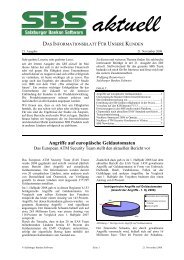96-DETC / DTM-1610
You also want an ePaper? Increase the reach of your titles
YUMPU automatically turns print PDFs into web optimized ePapers that Google loves.
Proceedings of<br />
The 19<strong>96</strong> ASME Design Engineering Technical Conferences and<br />
Computers in Engineering Conference<br />
August 18-22, 19<strong>96</strong>, Irvine, California<br />
<strong>96</strong>-<strong>DETC</strong> / <strong>DTM</strong>-<strong>1610</strong><br />
DESIGN FOR VARIETY:<br />
A METHODOLOGY FOR UNDERSTANDING THE<br />
COSTS OF PRODUCT PROLIFERATION<br />
Mark V. Martin<br />
Department of Mechanical Engineering<br />
Stanford University<br />
Stanford, CA<br />
mvmartin@leland.stanford.edu<br />
Kosuke Ishii<br />
Department of Mechanical Engineering<br />
Stanford University<br />
Stanford, CA<br />
ishii@cdr.stanford.edu<br />
ABSTRACT<br />
This paper further develops the previously introduced<br />
concept of Design for Variety (DFV). Our study seeks a tool<br />
that enables product managers to estimate the cost of<br />
introducing variety into their product line. This will help them<br />
to maximize market coverage while maintaining required<br />
profit margins. Variety incurs many indirect costs that are not<br />
always well understood or are difficult to capture. These costs<br />
are often not considered by people making the decision about<br />
introducing variety. Our DFV model attempts to capture these<br />
indirect costs through the measurement of three indices:<br />
commonality, differentiation point, and set-up cost. These<br />
indices will allow the decision makers to estimate some of the<br />
generally unmeasurable costs of providing variety. We<br />
conclude this paper by discussing our validation plans for<br />
testing the model in industry.<br />
1. INTRODUCTION<br />
In the past decade, Design for Manufacturability (DFM:<br />
Hinckley and Barkan, 1993) has significantly improved the<br />
product quality and profitability of US manufacturing<br />
companies. Two widely used DFM methods are Quality<br />
Function Deployment (QFD: Hauser and Clausing, 1988) and<br />
Design for Assembly (DFA: Boothroyd and Dewhurst, 1983).<br />
QFD provides a powerful tool in clarifying customer needs and<br />
translating them to design and manufacturing requirements.<br />
DFA enables engineers to create designs which are<br />
manufacturable at low cost. Despite the improvements in<br />
product quality, many companies are now realizing that<br />
applying DFM to a single product is not enough. By applying<br />
DFM methodologies to a single product, engineers may<br />
produce designs which optimize the cost of producing that<br />
product, but which sub-optimize the costs of producing all of<br />
the products together. Our goal is to develop a methodology<br />
which accounts for this interaction among the different<br />
varieties offered, and aids the product manager and engineers<br />
in making decisions about design issues affecting variety.<br />
Many companies today see this variety issue as a key to<br />
profitability.<br />
DFV refers to product and process design that meets the<br />
market demand for product variety with the best balance of<br />
design modularity, component standardization, late point<br />
differentiation, and product offering. Our research is<br />
developing a systematic design methodology that leads to a<br />
wide coverage of customer preferences, while reducing the<br />
manufacturing cost, shortening the production cycle, and<br />
enhancing product line flexibility.<br />
The key strategy in DFV is to identify the "standard"<br />
model and to utilize the methodology to design the products<br />
and processes that lead to short in-process time, low inventory,<br />
and low logistics costs. The concept of "late point
identification" (Steiner, 1994) tells designers to implement the<br />
variety towards the end of the manufacturing process and<br />
standardize elements that require long lead times. Ulrich and<br />
Eppinger (1994) point out that as functions per component<br />
increases, volume related costs decrease, while complexity<br />
related costs increase. Variety also impacts costs related to lifecycle<br />
service (Eubanks and Ishii, 1993) and recycling and<br />
reuse (Ishii et al., 1994). Hence, the goal of DFV is to estimate<br />
at the early stages of design the cost of providing variety.<br />
The motivation for the research has been driven by<br />
interest from many different companies into how they can<br />
properly manage variety. The authors have been working with<br />
manufacturers of industrial electronics, automobile<br />
components, and consumer appliances to develop these<br />
methods of determining variety costs. The first cost model<br />
(Ishii et al. 1995) gave a simple representation of variety and a<br />
very rough measure of variety complexity. Feedback from<br />
industry-provided student projects that used our model lead us<br />
to enhance our measure in three key areas: commonality,<br />
differentiation point, and setup cost.<br />
This paper describes this recent enhancement effort for<br />
measuring variety complexity. In section 2 we explain the<br />
significance of variety complexity in detail by citing examples<br />
from industry. The summary of our previous effort in capturing<br />
the cost and importance of variety comprises section 3. Section<br />
4 presents the enhanced measure of complexity and<br />
representation of variety. We outline the on-going validation<br />
plan in section 5, followed by concluding remarks.<br />
2. WHAT IS THE COST OF VARIETY?<br />
2.1 Scope of Variety<br />
First, let us determine the scope of what constitutes<br />
"variety." One can consider product variety at different levels:<br />
the entire company, a specific factory, or an assembly line. In<br />
our current research, we are mainly focused on variety "seen"<br />
by a particular assembly line. Another issue to consider is<br />
whether the decisions to be made are strategic or tactical.<br />
Strategic variety decisions are those that affect the number<br />
and scope of the variety offered to the customers. This is<br />
variety in the product that is noticeable to the customer. At the<br />
strategic level, the product manager is deciding what types of<br />
products to offer. A company should make such decisions<br />
based on whether the additional revenue realized from the<br />
introduction of the new variety will be more than the increased<br />
costs of providing it. These decisions involve the interaction of<br />
marketing and product design.<br />
Tactical variety decisions are made at the level of the<br />
design engineer and involve decisions that affect the<br />
manufacture of the product, but which are not obvious to the<br />
customer. This involves the use of different parts or processes<br />
for the product. For example, should a new frame be designed<br />
for the new line of computers? Or should the designers use the<br />
current frame that has higher material costs than a redesigned<br />
frame would have? These decisions require close collaboration<br />
between product design and manufacturing.<br />
Thus, we view DFV as a practice that truly requires<br />
concurrent engineering. From the engineer's viewpoint, DFV<br />
extends DFM to include marketing, service, and other product<br />
life-cycle issues that significantly impact profit.<br />
2.2 Design for Variety in Industry<br />
The topic of product variety has attracted a great deal of<br />
industry attention in the past several years. Hewlett-Packard<br />
(HP) has focused on efficient manufacturing of product variety<br />
as part of their global effort on streamlining supply chain<br />
(Davis and Sasser, 1995). The key point of their strategy is the<br />
postponement of differentiation. Davis and Sasser cite HP's<br />
successful redesign of laser jet printers. They now install<br />
localized modules including power supplies at worldwide<br />
distribution centers rather than at HP's factory in the US. Since<br />
different countries require distinct power supplies, this change<br />
in design eliminated the need for HP to produce localized<br />
printers in the US and allowed differentiation much closer to<br />
the customers. HP reports enormous savings due to the<br />
streamlined supply chain, reduced parts' inventory,<br />
documentation costs, and service logistics costs.<br />
Matsushita Electronic Industries is vigorously pursuing<br />
what they call the "fan" type manufacturing line (Nikkei<br />
Kogyo Shinbun, July 13, 1995). They report halving the<br />
manufacturing cost of their surveillance camera line. In their<br />
DFV effort, they reduced the number of distinct products from<br />
over 200 to <strong>96</strong> and implemented late point differentiation.<br />
They standardized the camera housing and printed circuit<br />
board, and postponed the differentiation until the last step in<br />
the assembly process. Matsushita considers DFV to be one of<br />
their key manufacturing strategies for the next decade and is<br />
applying the same philosophy in other products such as<br />
portable tape recorders.<br />
Automotive components and systems suppliers face the<br />
same challenge. The Nippondenso assembly line in Aichi,<br />
Japan produces over 250 different instrument panel meter<br />
consoles in a single line. Part of the line handles over 2000<br />
distinct meter console "backsheets". Their previous<br />
manufacturing line required 800 sheet-punching dies and 160<br />
setups per day. In redesigning their product line they identified<br />
the outside profile of the backsheet as the most expensive<br />
variety factor. Nippondenso now cuts the outside profile with a<br />
laser, which provides flexibility with lower setup costs and<br />
thus lowers the cost of variety. Coupled with other DFV<br />
improvements dealing with switchover costs, they were able to<br />
decrease the number of dies and setup time. In sum, they<br />
identified cost driving factors in design and manufacturing and<br />
generated alternatives that would reduce the cost of providing<br />
variety.<br />
Ishii et al. (1995) cite the GE Appliances case in which<br />
GE engineers reduced cycle time by almost one-third. They<br />
analyzed refrigerator variety, particularly the door systems.<br />
They combined focused customization (eliminating variety that<br />
does not bring profit) and late point differentiation designs to<br />
achieve improvements in manufacturing costs.<br />
2 Copyright © 19<strong>96</strong> by ASME
The authors learned that all these companies, while being<br />
able to generate improved designs by trial and error, are<br />
seeking a more systematic method to manage variety:<br />
maximizing market coverage yet containing the cost of<br />
providing variety. In particular, they expressed the need for a<br />
measure for variety complexity that guides the early stages of<br />
design and manufacturing decisions.<br />
2.3 What is Done Currently?<br />
Generally, when a product manager wants to determine if<br />
it is profitable to have more variety within a current or future<br />
product line, they look at the direct costs of increased variety.<br />
Will it require more capital equipment or more training of<br />
personnel? How many hours of engineering time will it require<br />
to make new drawings, analyze the new design, run<br />
certification or qualification tests, etc.? Will any suppliers have<br />
to be added? The consideration of indirect costs is more<br />
difficult, however. Costs that are difficult to determine include<br />
those costs associated with changes in:<br />
• raw material inventory<br />
• work in process (WIP) inventory<br />
• finished goods inventory (FGI)<br />
• post-sales service inventory<br />
• reduction in capacity due to set-ups<br />
• increased logistics of managing the variety<br />
of variety to the customer is being explored by other project<br />
members within the Industrial Engineering Department here at<br />
Stanford.<br />
3. PREVIOUS MODEL OF VARIETY COMPLEXITY<br />
3.1 The Initial Model<br />
A preliminary study (Ishii et al., 1995) revealed three<br />
main factors that affect the cost of providing variety: the<br />
number of variations, how late in the manufacturing process<br />
the variation is implemented, and how "painful" it is to change<br />
over from one variety to another. It proposed a very rough<br />
measure of cost of variety (Y) on a scale of [0,1]:<br />
where:<br />
Y = 1 - D1 • D2 • D3 (1)<br />
D1: number of variations (smaller if number of variations<br />
is large)<br />
D2: the stage in manufacturing (smaller if early in the<br />
process)<br />
D3: effort required to change over (smaller if the change<br />
takes more time).<br />
All three indices (D1, D2, D3) are based on a [0,1] scale.<br />
While a detailed analysis may be able to determine many<br />
of these costs, managers and engineers generally do not have<br />
the time or the resources to do such an analysis. What is<br />
needed is a method to quickly estimate the costs of introducing<br />
or reducing variety. Such a tool will help focus the decision<br />
makers on where variety can be added profitably and where it<br />
should be avoided.<br />
2.4 Research Approach<br />
Our research approach to a DFV methodology focuses on<br />
the following tools:<br />
1. Measure of the cost of providing variety: the team<br />
must be able to estimate the cost of providing variety.<br />
2. Representation of variety: product development teams<br />
need a procedure that allows them to identify the key<br />
dimensions of variety and concisely document the<br />
variety offerings in graphical form. The graph should<br />
also indicate pertinent design and manufacturing<br />
information that affects variety importance and cost.<br />
3. Measure of the importance of variety: development<br />
teams must estimate the importance of variety, i.e.,<br />
additional revenues that will result by offering a<br />
particular variety.<br />
Freezer door<br />
Legend: (X, Y)<br />
X = importance to<br />
customers<br />
Y = 1-D1xD2xD3<br />
D1 = number of<br />
variations<br />
D2 = position in<br />
mfg. process<br />
D3 = how<br />
"painful"<br />
SIZE<br />
27<br />
(0.9, 0.85)<br />
24<br />
(0.9, 0.85)<br />
22<br />
(0.9, 0.85)<br />
20<br />
(0.9, 0.85)<br />
ICE DISP?<br />
N<br />
(0.4, 0.78)<br />
Y<br />
(0.4, 0.78)<br />
N<br />
(0.4, 0.78)<br />
Y<br />
(0.4, 0.78)<br />
N<br />
(0.4, 0.78)<br />
Y<br />
(0.4, 0.78)<br />
SHELF<br />
TYPE<br />
MOD<br />
(0.7, 0.85)<br />
ID MOD<br />
(0.7, 0.85)<br />
MOD<br />
(0.7, 0.85)<br />
FIX<br />
(0.7, 0.85)<br />
ID MOD<br />
(0.7, 0.85)<br />
MOD<br />
(0.7, 0.85)<br />
FIX<br />
(0.7, 0.85)<br />
ID MOD<br />
(0.7, 0.85)<br />
FIX<br />
(0.7, 0.85)<br />
COLOR<br />
B<br />
W<br />
A<br />
B<br />
W<br />
A<br />
B<br />
W<br />
A<br />
B<br />
W<br />
A<br />
B<br />
W<br />
A<br />
B<br />
W<br />
A<br />
B<br />
W<br />
A<br />
B<br />
W<br />
A<br />
B<br />
(0.6, 0.85)<br />
W<br />
(0.6, 0.85)<br />
A<br />
(0.6, 0.85)<br />
The next section summarizes our first effort in developing<br />
this methodology (Ishii et al., 1995). This paper focuses on<br />
issues 1 and 2 -- the cost of providing variety and a method for<br />
representing variety. Research on measuring the importance<br />
Figure 1. Product Structuring Graph<br />
3 Copyright © 19<strong>96</strong> by ASME
Figure 1 shows the product structure graph for a<br />
refrigerator door. The factor X is a measure of the importance<br />
of a variety to the customer. The factor Y is the rough measure<br />
of the cost of providing that variety and is determined as<br />
discussed above. This information would help the company<br />
determine which varieties are expensive to provide, but which<br />
have relatively low value to the customer. By plotting these X<br />
and Y values on a normalized graph such as that shown in<br />
Figure 2, it may help the development team make decisions on<br />
the design.<br />
1<br />
Y: Cost<br />
of Variety<br />
Consider<br />
Dropping<br />
Variety<br />
OK<br />
Improve<br />
Design<br />
●<br />
■<br />
OK<br />
Good<br />
Design<br />
0<br />
X: Importance of Variety 1<br />
● Original<br />
Design<br />
■ Improved<br />
Design<br />
Figure 2: Cost of Variety vs. Importance of Variety<br />
3.2 Industrial Feedback<br />
These tools, the graph and the complexity measure, were<br />
used in ME217, a Stanford graduate course sequence in design<br />
for manufacturability. Three groups specifically applied the<br />
model to: 1) automotive window regulators, 2) heat trace cable<br />
connectors, and 3) hard disk drives. The groups indicated that<br />
the graph and the measure helped them clarify the variety<br />
structure, identify rough cost drivers, and guided them to<br />
redesign opportunities. However they saw some serious<br />
shortcomings in the methodology.<br />
1. The use of QFD in estimating the importance of<br />
variety is arbitrary and subjective: other project<br />
members are addressing this weakness by applying<br />
conjoint analysis (Elrod, et al., 1992) and utility<br />
theory (Thurston, 1990).<br />
2. The complexity measure was too rough and<br />
convoluted: it is useful for identification of cost<br />
drivers but was useless in trade-off analysis of detailed<br />
design decisions.<br />
3. The model is useful for a focused product line, but<br />
difficult to apply for very complex variety structures:<br />
the refrigerator example had a clearly defined<br />
dimension of variety that involved discrete choices.<br />
Other products with more convoluted product<br />
structures have been found to be more difficult to<br />
analyze using this methodology.<br />
The current effort for DFV involves refinement of the<br />
measurement indices to more accurately account for the cost of<br />
providing variety. As mentioned before, this paper focuses on<br />
our effort to enrich the indices and the representation of<br />
variety.<br />
4. THE ENHANCED MEASURE OF COST OF VARIETY<br />
4.1 Indices for Measuring Cost of Variety<br />
The core idea of a DFx tool is to use an easily measurable<br />
index to act as a proxy for the actual cost drivers for the<br />
product. For example, DFA uses the symmetry of the part,<br />
angle of insertion, etc., as proxies for the expected labor which<br />
will be needed to assemble the part. Similarly, DFV needs<br />
indices that designers can use to measure the indirect costs of<br />
providing variety. Note that our model does not address direct<br />
costs, since we consider them relatively straightforward to<br />
determine.<br />
In Ishii et al. (1995), we used the indices of D1, D2, and<br />
D3 (number of varieties, differentiation point, and set-up costs)<br />
as the proxies for variety complexity. More recently, we have<br />
been considering an expanded number of indices. We explored<br />
the use of the five indices shown below:<br />
• Degree of variety<br />
• Degree of commonality<br />
• Differentiation point<br />
• Value-added curve (Figure 3)<br />
• Set-up cost<br />
100%<br />
Value<br />
Added<br />
over<br />
Mfg.<br />
Cycle<br />
Figure 3.<br />
Inflexible<br />
product<br />
Flexible<br />
product<br />
0 Time<br />
Cycle<br />
Time<br />
Product cost build-up during the<br />
production cycle<br />
After carefully considering these five main cost drivers,<br />
we were able to combine them to come up with three indices<br />
similar to the D1, D2, and D3 indices of Ishii, but with more<br />
detail and information. For these three new indices, the degree<br />
of variation is subsumed into the degree of commonality<br />
measure, while the differentiation point index includes<br />
information on the value added-curves. Hence, our enhanced<br />
measures now consist of the following three indices:<br />
CI: Commonality index<br />
DI: Differentiation Point index<br />
SI: Setup Cost index<br />
4 Copyright © 19<strong>96</strong> by ASME
Our theory is that the different indices are correlated with<br />
various indirect costs of providing variety. These indirect costs<br />
include items such as inventory holding costs, maintenance of<br />
drawings and suppliers, training, learning curve losses, etc.<br />
The indices should allow a rough estimation of the indirect<br />
costs of providing variety, and thus will help product managers<br />
make more informed decisions about how much variety to<br />
offer. It will also help engineers understand how to design<br />
products and manufacturing systems which will decrease the<br />
costs of providing variety.<br />
Table 1 shows some of the costs of providing variety and<br />
indicates which indices we feel are correlated with the costs.<br />
In the following sections we give a detailed description of these<br />
indices.<br />
Table 1. Relation between indices and costs of<br />
providing variety<br />
Costs of Providing Variety CI DI SI<br />
LOGISTICS COSTS<br />
Drawing maintenance √ √<br />
Supplier maintenance<br />
√<br />
Expediting<br />
√<br />
Documentation √ √ √<br />
IT system √ √<br />
Management √ √ √<br />
MATERIAL COSTS<br />
Volume discounts<br />
√<br />
Material handling √ √<br />
LABOR COSTS<br />
Assembly (setups) √ √ √<br />
Training √ √<br />
Learning curve losses √ √ √<br />
HOLDING COSTS<br />
Raw mtl, WIP √ √ √<br />
FGI<br />
√<br />
Field service inventory<br />
√<br />
End of life buy<br />
√<br />
4.1.1 Commonality Index (CI)<br />
In the original indices, the "number of varieties" index<br />
was directly measured as the number of varieties at a given<br />
process (e.g., the number of different colors at the painting<br />
process). We felt that this did not sufficiently capture that there<br />
may be different "degrees" of variation and that simply<br />
counting the number of varieties is not adequate to accurately<br />
measure the cost of that variety. For instance, in the original<br />
index, a painting process with three different colors would be<br />
equivalent to a sheet-metal forming process which produced<br />
three different shapes. The question is, would these two<br />
processes be equivalent in the impact they have on<br />
manufacturing costs? The answer is probably not. The paint<br />
process may simply require the purging of the paint gun before<br />
switching over to a new color, while the sheet metal process<br />
may require time-consuming die switchovers, extra training<br />
due to complexities associated with the different shapes, etc.<br />
Thus, some method is needed to account for the degree of<br />
variation within the process. This is important because it will<br />
account for the fact that adding a fourth color may be much<br />
cheaper than adding a fourth shape.<br />
In developing a measure for the degree of variation, it<br />
became evident that the setup cost index captures part of this.<br />
It is tautological, but a high setup cost implies a high degree of<br />
variation between the products. However, the setup cost index<br />
does not capture all the cost factors. The raw material or subassembly<br />
inventory holding costs, the logistics in handling<br />
various parts, the loss of learning curve effects, etc., are all<br />
costs which may vary based on the degree of variation between<br />
the different varieties. Another index needs to be used to<br />
account for this factor.<br />
We propose the use of what is sometimes called a<br />
commonality index (Collier 1981). This is a measure of the<br />
percentage of parts that are reused for other product models on<br />
that manufacturing line. This index accounts for the utilization<br />
of standardized parts and is shown below:<br />
CI =<br />
u<br />
vn<br />
∑<br />
pj<br />
j=<br />
1<br />
0 < CI ≤ 1<br />
u = # unique part numbers<br />
p j = # parts in model j<br />
v n = final # of varieties offered<br />
A lower index number indicates a high degree of<br />
standardization. For instance, assume that you had five<br />
variants of a refrigerator door, with each variant using ten<br />
parts, then the denominator would be fifty (5 x 10). If there<br />
were no two parts alike (i.e., there were fifty unique parts),<br />
then the CI for the door line would be one (1), which is the<br />
"worst" commonality index possible. If on the other hand you<br />
only required 25 unique parts to build these five different<br />
doors, then the commonality index would be 0.5, indicating a<br />
higher degree of standardization.<br />
4.1.2 Differentiation Point Index (DI)<br />
All other things being equal, one wants the differentiation<br />
point for a variety to be placed later in the process flow. This<br />
will decrease the size of the safety inventory required early in<br />
the flow. Any measure that is used should account for the<br />
placement of the differentiation point. One possible index (DI)<br />
is:<br />
(2)<br />
5 Copyright © 19<strong>96</strong> by ASME
DI<br />
n<br />
nv<br />
vi<br />
∑1 i<br />
1 = = n<br />
0 < DI1 ≤ 1<br />
v i = # of different products exiting process i<br />
n = # of processes<br />
v n = final # of varieties offered<br />
The denominator normalizes the index between 0 and 1. A<br />
lower index indicates that differentiation is occurring later.<br />
DI 1 , however, does not account for the time it takes the<br />
products to flow through the system. For instance, even if the<br />
product is differentiated at the second to last process, if the<br />
throughput time between that process and the last process is<br />
large compared to the overall throughput time, then there is a<br />
much larger effect on costs than the DI 1 measure will show. To<br />
account for this, a proposed measure is to weight the DI 1 factor<br />
by the throughput time (TPT) from process i to the sale of the<br />
product. This is shown below in DI 2 .<br />
(3)<br />
all of the varieties (n) are determined in the first process and<br />
all of the costs are incorporated at that point. The numerator<br />
reflects to what extent the product structure has moved away<br />
from this worst case situation. The lower the number the<br />
better. Thus, as DI 3 approaches zero, costs associated with this<br />
index (WIP inventory, documentation for the various assembly<br />
instructions, etc. -- see Table 1) will decrease.<br />
4.1.3 Setup Cost<br />
This measure is similar to the original measure, D3, but it<br />
utilizes estimated setup costs rather than set-up times. It also<br />
aggregates all the different setups for the product and<br />
normalizes it with the expected total direct costs of the all the<br />
products being offered. The index measures the percentage<br />
cost contribution of setups to the total costs for the products.<br />
SI<br />
n<br />
∑<br />
i<br />
= = 1<br />
vn<br />
∑<br />
j=<br />
1<br />
vic<br />
i<br />
Cj<br />
(6)<br />
DI<br />
2<br />
n<br />
∑ divi<br />
i 1<br />
= = nd1vn<br />
0 < DI 2 ≤ 1<br />
(4)<br />
0 ≤ SI ≤ 1<br />
v i = # of different products exiting process i<br />
c i = cost of set - up at process i<br />
C j = total cost (material, labor, and overhead) of<br />
jth product<br />
d i = average throughput time from process i to<br />
sale<br />
d 1 = average throughput time from beginning<br />
of production to sale<br />
However, there is one last factor that must be incorporated<br />
into the measure, and that involves the value-added amount<br />
that is being "carried". If much value is added early on in the<br />
process flow, then early differentiation is going to have a<br />
larger negative impact than if most of the value is added<br />
towards the end of the process flow. This is incorporated in the<br />
following index (DI 3 ):<br />
DI<br />
3<br />
n<br />
∑<br />
i = 1<br />
=<br />
nd1v<br />
diviai<br />
n<br />
n<br />
i=<br />
1<br />
∑ai<br />
0 < DI 3 ≤ 1<br />
a i = value added at process i<br />
DI 3 becomes the index that we use for our model. The<br />
denominator indicates the worst possible case, which is where<br />
(5)<br />
One concern about this index is that the costs of a setup is<br />
non-linear. For instance, if there is excess capacity in the<br />
factory, including labor, the true cost of a new setup might be<br />
considered zero. Thus, this index is dependent on the<br />
utilization rates in the factory for both machines and labor. For<br />
our current model, this complexity will not be incorporated.<br />
4.2 Cost of Providing Variety<br />
Determination of the variety effects on the cost requires a<br />
method to aggregate the various descriptive indices. One can<br />
consider the aggregate as a regression of the dependent<br />
variable of costs against the indices:<br />
Ψ = β 0 + β 1C I + β 2DI + β 3SI<br />
(7)<br />
Ψ = indirect costs of providing variety<br />
β 0 , β 1 , β 2 , β 3 = regression coefficients<br />
Direct costs related to providing variety (such as material,<br />
labor, and designing costs) are relatively straightforward to<br />
determine. It is the indirect costs that our index is trying to<br />
capture. The idea is that the regression equation above should<br />
give us a method for estimating many of these costs. The<br />
equation above might have different coefficients based on the<br />
industry, capacity utilization of the factory, etc. Part of our<br />
6 Copyright © 19<strong>96</strong> by ASME
Wide spread shows the cost of switching<br />
between different sizes. In this instance,<br />
there is a wider spread between this product<br />
size and the others because this size requires<br />
a different size paint oven to be used which<br />
involves higher setup costs due to higher<br />
capitalization.<br />
Large circle indicates that lots<br />
of direct labor and material are<br />
imparted at this process<br />
Tight cluster implies that<br />
switching between colors is<br />
relatively inexpensive<br />
Size<br />
Distance indicates the average<br />
TPT between processes for<br />
the product.<br />
Color<br />
Ice Disp<br />
Processes are placed in order of actual flow<br />
Distance between processes = average flow time between processes<br />
Size of Circle = direct costs (labor & material $) at that process<br />
Spread of circles within clusters = set-up costs (include real costs of machine utilization)<br />
Spread of clusters = added set-up costs for dealing with incoming variety<br />
Shelf type<br />
Customer Sale<br />
Figure 4. Graphical Representation of Variety<br />
contribution is to determine if this equation will be valid and at<br />
what level we might be able to generalize it.<br />
The variety cost index is a method of "allocating" (e.g.,<br />
estimating) indirect costs for a planned product. In that sense,<br />
it is analogous to an activity-based costing (ABC) system. If a<br />
company has a well-developed ABC system, will they need the<br />
Index? The answer is -- it depends. The ABC system would<br />
have to be well developed to account for such items as supply<br />
chain costs and post-sales service costs. In a "perfect" ABC<br />
system, our index would not be needed, but very few<br />
companies have comprehensive ABC systems. For most<br />
companies, our index could be used to help estimate the<br />
indirect costs for providing variety.<br />
4.3 Graphical Representation of Variety and<br />
Complexity<br />
Schematic representations are often useful in<br />
communicating simply and clearly the basic information of a<br />
system. Quality Function Deployment (Clausing 1991) and KJ<br />
diagrams (Shiba et al. 1993) utilize graphical techniques to<br />
enhance the decision making process. Such a tool could be<br />
useful for variety discussions between marketing, product<br />
design and manufacturing.<br />
The proposed graphical tool is a refinement of the<br />
original product structure graph (seen in Figure 1). Where<br />
there is a variation introduced into the product, a branch is<br />
sprouted. The new graph (see Figure 4) should quickly<br />
communicate to the product design team how their product<br />
offerings fare with respect to the costs of providing variety.<br />
Such a visual aid can help in design review meetings where<br />
marketing, product design, and manufacturing negotiate what<br />
varieties to offer.<br />
The new product structure graph gives a visual indication<br />
of the cost drivers of providing variety. The process flow is<br />
shown from the left to right with variations in the product<br />
shown in the branches. In addition, the graph shows the<br />
following information:<br />
• average estimated flow time between the processes<br />
• setup costs at each process<br />
• the amount of value-added material and labor at each<br />
process<br />
The graph indicates the estimated flow time between<br />
processes as the horizontal distance on the graph. For this,<br />
designers use an educated guess of the average throughput<br />
time between successive processes. The setup costs will be the<br />
7 Copyright © 19<strong>96</strong> by ASME
estimates of the costs involved in switching from one variation<br />
to another within a process. The graph shows these setup costs<br />
in the vertical separation between the circles. Finally, the<br />
value-added amount for each process is indicated by the size of<br />
the circle.<br />
This representation graphically shows how the costs of<br />
providing variety can be reduced.<br />
1) Differentiate as late as possible, indicated by the<br />
branching occurring far to the right<br />
2) Shorten the time between the processes, seen as a<br />
horizontally shorter graph.<br />
3) Reduce set-up costs, indicated by a tight vertical<br />
clustering of circles.<br />
4) Delay the addition of value to the product to later in<br />
the process flow, indicated by the largest circles being<br />
to the right.<br />
A visual representation of the product can quickly show<br />
the team where variety can be added inexpensively, and where<br />
adding it could be expensive. Using such a representation in<br />
initial meetings can help the team in deciding what variety to<br />
offer and help determine where the company should spend<br />
their resources in trying to reduce the costs of variety.<br />
5. VALIDATION PLAN<br />
As with other design methods and tools, the true<br />
validation is in the competitiveness enhancement attributable<br />
to the deployment of the tool. Thus, the essential ingredient of<br />
our validation plan is to team with industry to work on<br />
commercial examples. For the tools that we have proposed in<br />
the previous section, the enhanced product structure graph and<br />
the variety cost index, the key questions are as follows.<br />
1) Does the variety cost index reflect the true cost of<br />
providing variety?<br />
2) Can design teams easily create the product structure<br />
graph?<br />
3) Do the graph and index aid managers and designers in<br />
managing variety more efficiently?<br />
Of these questions, the most critical and challenging is the<br />
first -- how do we validate the cost index? We intend to use<br />
direct collaboration with companies and graduate student<br />
projects to achieve this goal.<br />
ME217, Stanford’s design for manufacturability<br />
curriculum, provides a rich opportunity for validating various<br />
simultaneous engineering methods and tools. Student teams<br />
work on industry provided problems related to product<br />
competitiveness over a six month period. The last several years<br />
have seen an increase in projects that address<br />
manufacturability of product families and management of<br />
product line structure. As part of this effort, the students will<br />
gather cost information (often in normalized form) and attempt<br />
to improve the design for reduced cost of variety. For 19<strong>96</strong>, a<br />
domestic electronic instruments' manufacturer and hard disk<br />
supplier have defined design for variety projects for the<br />
students. These projects will help us calibrate the variety cost<br />
index with the actual cost of variety.<br />
More rigorous validation will come from our direct<br />
collaboration with industry. We are scheduling workshops in<br />
which engineers from industry will use our DFV methodology<br />
and compare the variety cost index with actual cost data. The<br />
most promising validation method is for industry to provide<br />
information on product design and manufacturing<br />
specifications with associated cost data, and we will gauge the<br />
actual costs against the calculated indices. Participating<br />
companies include a domestic commercial aircraft<br />
manufacturer, a Japanese automobile component supplier, a<br />
telecommunications company, and a semiconductor fabrication<br />
equipment manufacturer. Through this effort, we intend to<br />
validate monotonicity between our index and the actual cost,<br />
and further develop a procedure to calibrate the tool for<br />
different product types and individual companies. Our<br />
experience with other DFx tools gives us confidence in<br />
validating and enhancing this important method of design for<br />
variety.<br />
6. CONCLUSION<br />
Over the past few years, two issues have become mantras<br />
for corporations throughout the world: “mass customization”<br />
and “meeting or exceeding the customer's needs”. Companies<br />
have rushed to offer a range of products that covered almost<br />
every configuration their target market might want. However,<br />
as the number of products being offered by companies grew<br />
larger, it became evident that the cost estimates used to<br />
determine the profitability of these new product offerings did<br />
not fully account for all the costs associated with providing this<br />
variety. Increased inventories above what was expected,<br />
additional setups, and the complexity of managing the<br />
increased variety were not always included in the original cost<br />
estimates, and the expected profits did not follow because of<br />
these factors. These additional cost drivers were not included<br />
because of the difficulty in estimating their effects.<br />
The design for variety (DFV) methodology is a basic<br />
procedure for helping managers and engineers understand the<br />
true costs of introducing variety into their product line.<br />
Through the use of indices that are relatively easy to measure<br />
or estimate, we plan on giving the managers a tool to help<br />
them make informed decisions about variety.<br />
Over the next few months, we will apply the DFV<br />
methodology to a number of industry sponsored projects.<br />
Utilizing these projects we will determine appropriate<br />
regression coefficients for our DFV index, and analyze the<br />
validity of the methodology.<br />
ACKNOWLEDGMENTS<br />
The sponsors of this research include the National Science<br />
Foundation and the Stanford Integrated Manufacturing<br />
Association. The authors would like to thank Kyle Cattani,<br />
Dakai Chen, and Warren Hausman who are our partners in<br />
this project in Stanford’s Department of Industrial Engineering<br />
8 Copyright © 19<strong>96</strong> by ASME
and Engineering Management. We would also like to thank<br />
our industrial collaborators at GE, Hewlett-Packard, Boeing,<br />
Nippondenso, and Matsushita.<br />
REFERENCES<br />
Boothroyd, G. and Dewhurst, P., (1983). Design for Assembly: a<br />
Designer's Handbook. Boothroyd Dewhurst Inc., Wakerfield,<br />
Rhode Island.<br />
Clausing, Don (1991). Concurrent Engineering: Design and<br />
Productivity International Conference. Honolulu, Hawaii, February<br />
6-8, 1991.<br />
Collier, David (1981). “The Measurement and Operating Benefits of<br />
Component Part Commonality,” Decision Sciences, Vol. 12, No. 1,<br />
January 1981, pp. 85-97.<br />
Davis, T. and Sasser, M. "Postponing product differentiation."<br />
Mechanical Engineering. November 1995, pp.105-107.<br />
Elrod, T., Louviere, J. and Davey, K., "An Empirical Comparison of<br />
Ratings-Based and Choice-Based Conjoint Models." Journal of<br />
Marketing Research. Vol. XXIX, 1992, pp. 368-377.<br />
Eubanks, C. F. and Ishii, K. (1993). “AI Methods for Life-cycle<br />
Serviceability Design of Mechanical Systems.” Artificial<br />
Intelligence in Engineering (Elsevier), Vol. 8, pp. 127-140.<br />
Hauser, J. and Clausing, D. (1988). "The House of Quality." Harvard<br />
Business Review. May-June 1988, pp. 63-73.<br />
Hinckley, M., Barkan, P., "Benefits and Limitations of the DFA<br />
Structured Methodologies in Product Design." ASME<br />
Manufacturing Review. vol. 6, no. 3, September 1993<br />
Ishii, K., C.F. Eubanks, DiMarco, P. (1994). “Design for Product<br />
Retirement and Material Life-cycle.” Materials and Design. Vol.<br />
15, No. 4, pp. 225-233.<br />
Ishii, K., Juengel, C., Eubanks, C.F. (1995). "Design for Product<br />
Variety: Key to Product Line Structuring." ASME Design<br />
Technical Conference Proceedings. September 1995. Boston, MA.<br />
Vol.2, pp. 499-506.<br />
Shiba, S., Graham, A., and Walden, D. (1993). A New American<br />
TQM. Productivity Press. Cambridge, MA.<br />
Shingo, Shigeo (1981). “Study of ‘Toyota’ Production System from<br />
Industrial Engineering Viewpoint.” Japan Management<br />
Association. Tokyo, 1981.<br />
Steiner, Mark W. (1994). Product Line Structuring. Presentation<br />
notes at GE Quality Symposium, GE CR&D. Schenectady, New<br />
York. September 1994.<br />
Thurston, D. (1990). "Subjective Design Evaluation with Multiple<br />
Attributes." ASME Design Theory and Methodology Conference.<br />
Vol. 27, pp.355-361.<br />
Ulrich, Karl T. and Steven D. Eppinger, (1994).<br />
Methodologies for Product Design and Development,<br />
McGraw-Hill.<br />
REV 1 - 4/16/<strong>96</strong>: corrected format errors and changed





